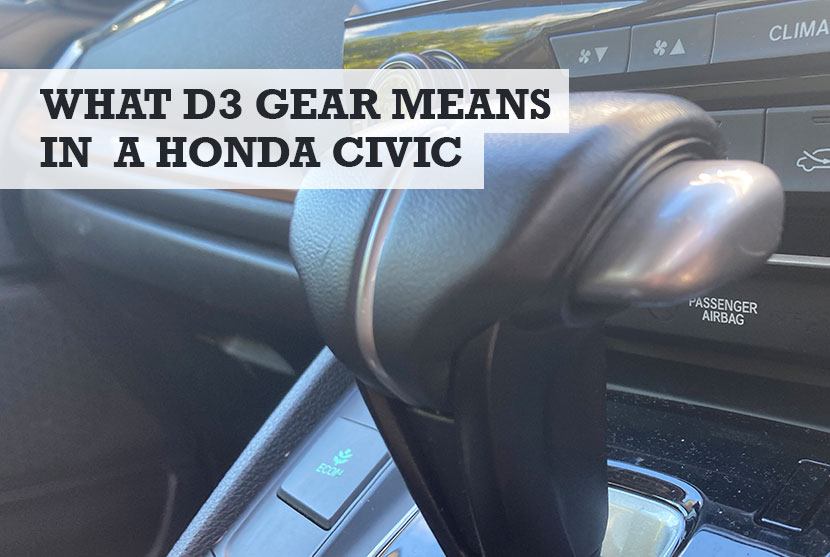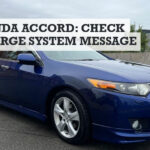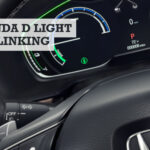The Honda Civic, just like every other car, is equipped with gears to regulate vehicle speed and engine RPM and transfer power from the engine to the wheels. While most people only recognize the D (Drive), P (Park), R (Reverse), and N (Neutral) parts of their vehicle’s gear system, you might have noticed a confusing D3 Honda Civic gear.
If you’re not familiar with it and know what D3 is used for in a Honda Civic, read on. I’ve also explained when to use the D3 gear, what it’s good for, and the advantages of using it. Here’s a very simple overview first though.
What does d3 mean in a Honda Civic? D3 in a Honda Civic is a gear position under the D (Drive) mode of the Civic’s gear system. The D3 gear is the third gear in the gear train, making use of the first three gears in an automatic. Driving a Honda Civic in D3 will give around a 15% improvement on gas mileage.
In manual transmission Honda Civic cars, the D3 means shifting the vehicle into a lower gear (down-shifting). However, in an automatic Honda Civic car, the D3 gear is a lower gear used that then provides the engine with a higher rotation rate needed to produce more back pressure than allowed at a higher gear.
In summary, the Honda Civic D3 gear improves your car’s driving condition in diverse ways. But how exactly? Here’s all you need to know.
What is D3 in a Honda Civic and how does it work?
The D3 is a gear position in the Honda Civic that ensures a smooth driving experience by engaging only your vehicle’s rear wheels in harsh conditions such as steep hills, sand, gravel, and icy roads.
The D (Drive) gear position is the gear shifting for the forward drive mode. When this gear position is engaged, the gears automatically change through hydraulics. It should not be confused with L gear.
The D gear is the default driving gear, and when engaged, it allows the gear to switch between any of the available forward gears depending on the condition of the road and the way you drive.
Your vehicle’s electronic control unit determines the best gear to be used, after considering many factors, to save fuel and ensure efficiency.
However, when the Honda Civic’s D3 gear is engaged, the gear cannot exceed the third gear no matter the conditions of the road or your driving manner. The D3 gear also helps to provide a higher RPM (revolutions per minute) range for each gear, depending on their pull and power.
The D3 gear provides engine braking; therefore, it can be engaged while ascending or descending a steep hill.
As well as that the D3 gear comes in handy in situations such as a traffic jam, when approaching a red light, or even a brake failure. The gear position helps to slow down your vehicle without applying the brakes.
Related questions on D3 in Honda Civic
Why is my Honda Civic D3 light flashing?
If the D3 light starts flashing in your Honda Civic it could mean there’s a problem with the transmission. There are many possible reasons for this fault including low transmission fluid, mechanical fault with the gears, or a pressure switch.
What does D D1 D2 D3 mean?
- D1 means: If your car is starting to struggle in terrain such as sand, you can slip it into D1 gear, and it should help you get out of any sticky situations.
- D2 means: Let’s say you are climbing a hill or steep incline, put the car into the D2 gear and it will give you a boost, like how you might shift down in a manual transmission.
How to use the D3 gear in your Honda Civic
Now that you know what the D3 gear is in a Honda Civic, if you have never use this gear position before in your Honda Civic, the following steps will guide you on how to use D3 properly.
Before engaging the D3 gear, ensure that your car is in the D (Drive) mode, as this makes your Civic use the lowest gear available to provide high torque. Acquire speed up to 30/40 km/hr before shifting to the D3 gear. With the automatic transmission vehicles, you can switch to D3 from D while in motion. Engaging the D3 gear limits how high the transmission goes.
If you want to slow down, shift your gear back to D. Depending on the condition of the road, gain speed before deciding to engage the D3 gear again. If the revolutions per minute (RPM) get higher than usual, return the gear to D to avoid undue wear or tear on the engine or transmission.
Is it ok to drive your car in D3?
D3 should only be used to drive
No. D3 is not ideal for driving on the highway because D3 is usually engaged to enable braking while driving down a steep hill. Also, D3 provides optimum speed in a stop-and-go situation, especially in a busy city. It is ideal when driving at a speed level of 30 mph or less.
Does D3 make your car faster?
No, ordinarily, engaging the D3 gear does not make your Honda Civic any faster than normal. However, the D3 gear gives you higher revolutions per minute (RPM) than the other gears. For faster acceleration, while engaging the D3 gear, pushing the accelerator pedal to the floor automatically downshifts the transmission.
The D3 gear also distributes power across the axles effectively. D3 gear ensures a good driving experience as it adjusts to every driving condition. The table below indicates the maximum speed for each gear position.
| Gear position | Maximum speeds |
| 1 | 37 mph (60 km/h) |
| 2 | 66 mph (106 km/h) |
| D3 | 99 mph (160 km/h) |
| D4 | Top speed |
Exceeding these maximum speeds would send the engine speed into the tachometer’s red zone. This will cause the engine to cut in and out.
Advantages of the D3 gear in a Honda Civic
The following are the advantages of engaging the D3 gear while driving:
- It is suitable for severe driving conditions. When the D3 gear is engaged, it is easier to drive uphill, downhill, and navigate slippery surfaces.
- It gives you more control over your vehicle. When the D3 gear is engaged, your car runs at lower gears, and you gain more traction.
- It reduces damage to the brakes. The D3 gear reduces your need for brakes as the engine can reduce speed on its own when the D3 gear is engaged.
- It produces a better throttle response. Engaging the D3 gear makes your car run at lower gears which can help get the revolutions per minute (RPM) higher for faster acceleration.
- It ensures that the gearing does not exceed the engaged gear, enabling traction at low speeds.
Handy Hint: The Honda Civic is one of the most stolen cars in the United States, here’s why.
Can driving in D3 damage my car?
It is not a good idea to drive in D3 for long periods as this can result in wear on the vehicle’s transmission. The D3 gear has engine braking, and this means you will not need to use your brake to slow down at most times.
This can wear out your brakes because you do not use them as regularly as they should. It would be best to drive in D (Drive) mode until you need the power that comes with the D3 gear. This method helps save fuel and protects your car from wear and tear.
It is not recommended to drive in D3 while on the highway. The D3 gear is most effective in driving in harsh conditions such as sandy roads, driving uphill and downhill, and hauling loads. Use the D on the highway because driving 70mph on D3 can cause damage to your engine.
Is D3 gear good for snow?
Yes. You can use D3 when driving your Honda Civic in snow if you want to control your momentum via engine braking.
One thing you should keep in mind when driving in D3 is that you will burn more gas.
What social media says…
Here’s what someone asked on Facebook and then heard back about the D3 gear.
Dumb question lol. Does anyone know what d3 is used for? Just wondering I’m new to Honda Civics I’ve only had trucks in the past.
The answer…
I am pretty sure the older generation Civics had D then D3, D2, and L for low gears and to cap out the automatic gear shifting to that selected drive i.e.) D2 would automatically shift out of first into 2 but not into 3rd.
Conclusion
Now you know what D3 is good for in a Honda Civic, you can use it providing the circumstances require it.






